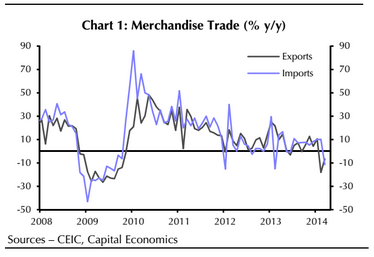What's fueling the stock market sell-off?
The recent market volatility continued on Friday in what, in some sectors, has been the worst wipeout in nearly three years.
The losses Thursday alone more than erased the previous session's gains, as the promise of more cheap money stimulus from the Federal Reserve just couldn't stem the selling pressure. The weakness was concentrated in the popular big technology and biotech stocks that were leaders in 2013 -- but have since succumbed to persistent underperformance.
At a time of record investor bullishness, aggressive fund positioning, record low cash levels and a "hear no evil, see no evil" attitude, all of this is coming as a major surprise for many investors. Especially after 2013's record gains amid an easy, low-volatility rise.
So what went wrong? Simply put: Despite everything, the global economy is slowing.
Previously, everything seemed just fine. The Fed was apparently beholden to the market's whims, gingerly pulling back whenever its desire to normalize its policy stance disrupted the good feelings on Wall Street.
We saw that all last year as former Fed chairman Ben Bernanke spent most of the year trying to restore confidence after hinting in May that the ongoing "QE3" bond purchase program could start winding down. Months passed, and the much dreaded tapering of the program didn't start until the very end of the year.
That dynamic seemed to be in play again on Wednesday.
The market interpreted the release of the Fed's March meeting minutes to represent some backpedaling from a harsher-than-expected policy announcement and post-meeting press conference on March 19. It was there that new Fed chairman Janet Yellen let slip that short-term interest rates could start rising as soon as early 2015 -- six months or so sooner than Wall Street had priced in.
Stocks reacted negatively to that revelation, starting the downtrend that continues now. The tech-heavy Nasdaq is now down 7.3 percent from its pre-Fed highs in early March.
Yesterday, it seemed like the Fed tried to pull the timing of the first rate hike back toward the tail end of 2015. At least, that was the market's response.
But a problem has materialized deep within the bowels of the market: The yen carry trade, which I discussed last month, started to melt as the U.S. dollar weakened in response to the Fed news. The proxy for this trade, the ProShares UltraShort Yen (YCS), threatens to fall out of a four-month long support level -- a development that would cause the stock market's losses to accelerate.
Japan's stock market peaked in late December, in unison with the yen carry trade, and has been drifting lower ever since as hopes are shattered that the nation's weaker currency would end Japan's multidecade malaise.
And this gets to the core of why stocks around the world are selling off now: Despite the efforts of the central banks, and the trillions in cheap money that have been pumped into the system, the global economy is hitting a wall and threatening corporate profits.
Here at home, the economic data have been warning of trouble for months as the Citigroup Economic Surprise Index has fallen to a level not seen since the middle of 2012. This index drops when the economic data consistently come in below analyst estimates. This not only measures what's happening in the economy, but it measures where market expectations are.
When expectations are high but the data are weak -- which is the situation now -- the stock market tends to underperform.
And it was weak economic data out of Japan and China overnight that really catalyzed Thursday's losses. Japanese machine orders dropped nearly 9 percent in February over January. And in a possible sign of deepening trouble in China, both import and export volumes tumbled in March.
So, there you have it. An overconfident, overleveraged market with too much faith in the power of cheap money is now suffering its worst sell-off in years. Significant technical support has already been lost. And with both the economic data and corporate earnings likely to keep disappointing in the near term, the evidence suggests more downside to come.
I continue to recommend that investors raise cash and move into defensive assets including Treasury bonds and precious metals. The Gold Trust SPDR (GLD) has moved back above its 50-day moving average for the first time since January. I added the leveraged ProShares UltraGold (UGL) to my Edge Letter Sample Portfolio earlier this week.
Anthony Mirhaydari is founder of the Edge and Edge Pro investment advisory newsletters, as well as Mirhaydari Capital Management, a registered investment advisory firm.



